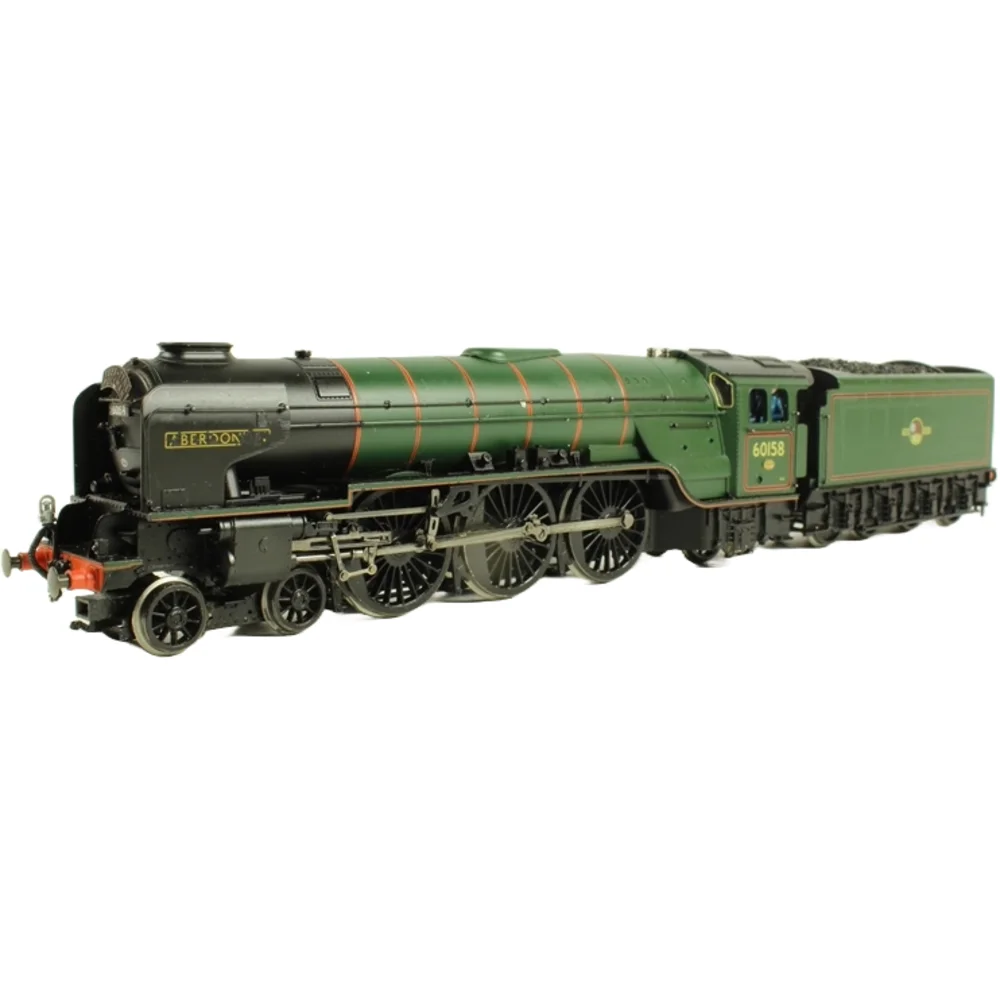Bachmann 32-551
London & North Eastern Railway A1 Peppercorn 60158 "Aberdonian" British Railways Lined Black with Late Crest
Tooling
Bachmann introduced its OO gauge model of the LNER Peppercorn A1 Pacific in 2001 under the Branchline range. This was the first ready-to-run representation of the class in OO scale, aimed at capturing the appeal of these post-war express locomotives designed by Arthur Peppercorn for the East Coast Main Line. The tooling pre-dates later upgrades in 2005 and 2010, and represents Bachmann’s early 2000s approach to high-detail steam models.
Tooling Features
- Scale: OO gauge (1:76).
- Construction: Combination of plastic and die-cast metal components; screw-assembled body and chassis.
- Detailing: Factory-fitted handrails, lamp irons, smoke deflectors, safety valves, and whistle. Additional detailing parts (drain cocks, fire irons, bufferbeam pipes) supplied in accessory packs. Glazed cab windows, painted cab interior, fallplate and footplate doors included.
- Couplings: NEM pockets with tension-lock couplers; sprung buffers fitted.
- Finish: Chemically blackened wheels and fluted connecting rods with an oily finish for realism.
Mechanical & Electrical
- Motor: 3-pole motor located in the locomotive chassis. Early batches (notably 32-551 and 32-552) suffered from underpowered motors and were subject to a recall for re-motoring with Mashima units.
- Drive: Loco-driven with pickups on all wheels except rear pony truck.
- Minimum Radius: Recommended for second radius curves (approx. 438 mm).
- Lighting: No factory-fitted lighting.
- Weighting: Moderate weight; many users added lead for improved traction.
DCC Capability
The 2001 tooling was DCC compatible but not DCC ready. No decoder socket was provided, requiring hard-wiring for digital conversion. There was no provision for a speaker for sound installation.
Liveries Produced
Initial releases covered key British Railways schemes:
- BR Lined Green with Early Emblem (Era 4).
- BR Lined Green with Late Crest (Era 5).
- BR Express Passenger Blue (1949–1955).
- BR Apple/Doncaster Green (Silver Lining).
These were applied to named locomotives such as Aberdonian, North Eastern, and North British.
Reviews & Commentary
The 2001 Peppercorn A1 was praised for its overall accuracy and fine detailing, setting a new standard for RTR steam models at the time. However, early batches attracted criticism for:
- Underpowered motors prone to overheating and poor haulage, later corrected via recall.
- Cab droop and running plate alignment issues, which could be adjusted by users.
- Lack of factory DCC socket, making digital conversion more complex.
Despite these issues, enthusiasts valued the model’s appearance and potential for modification. Many owners reported improved performance after adding weight and adjusting springing.
Media & Community Feedback
Model railway forums and YouTube reviews from the mid-2000s highlighted the A1’s strong visual appeal and its suitability for heavy express trains once upgraded. RMweb discussions noted variability in assembly quality and the absence of lighting compared to later A2 releases. The tooling remains popular among collectors for its historical significance as Bachmann’s first Peppercorn A1.
Interesting Notes
- The recall for motor replacement was one of Bachmann’s earliest large-scale after-sales interventions.
- These models often appear in weathered or modified form on layouts, with added lead and hard-wired decoders being common upgrades.
Class & Prototype
- Class: London & North Eastern Railway A1 Peppercorn
- Traction: Steam
- Built: 1948-1949
- Total Built: 50
- Running Number: 60158
- Name: Aberdonian
- Ordered By: London & North Eastern Railway
- Built By: British Railways
- Built At: Doncaster
- Built: 11/1949
- Withdrawn: 12/1964
- Length of Service: 15.1 years
- Running Numbers: BR 60158
- Names: Aberdonian
Operator & Livery
- Operator: British Railways
- Livery: Lined Black with Late Crest
British Railways transformed Britain's fragmented rail network into a unified national system following nationalisation on 1st January 1948. Created from the "Big Four" companies under the Transport Act 1947, BR operated most of Great Britain's railways until rebranding as British Rail in 1965, managing over 20,000 route miles and inheriting nearly 20,000 locomotives of diverse designs.
The organisation pioneered standardisation through its revolutionary BR Standard locomotive programme (1951-1960), producing 999 advanced steam engines under Robert Riddles' direction. These included the versatile Britannia Pacifics, mighty 9F freight engines, and mixed-traffic classes that incorporated the best features from all predecessor companies. The 1955 Modernisation Plan accelerated diesel and electric traction development, creating fascinating mixed-traction operations.
Notable achievements included establishing unified locomotive classification systems, introducing distinctive corporate liveries, and managing the complex transition from steam to modern traction. BR's six regional structure preserved operational diversity whilst enabling standardisation of practices, signalling, and rolling stock that had eluded private enterprise for over a century.
The BR era represents steam traction's final flowering alongside emerging diesel technology, creating unparalleled locomotive variety. Today, this heritage remains highly popular with railway enthusiasts through extensive preserved fleets, heritage railway operations, and comprehensive model ranges from manufacturers like Hornby, Bachmann, and Dapol, making BR subjects essential for authentic post-war British railway modelling across all scales.
